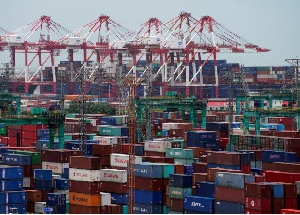Opinions of Thursday, 1 June 2023
Columnist: Joshua Gyaminu
Road traffic accidents: A real pandemic in Ghana
Imagine you are driving on a highway in Ghana. You are enjoying the scenery and the breeze. You are listening to your favourite music and chatting with your friends. You are looking forward to reaching your destination and having a good time.
Suddenly, you hear a loud bang. You feel a jolt. You see smoke and fire. You smell blood and gasoline. You hear screams and sirens. You realize you have been involved in a road accident.
This is not a horror movie. This is a reality for many Ghanaians who use the roads every day. Road traffic accidents are a serious threat to the lives and livelihoods of millions of Ghanaians. They are also a drain on the economy and a hindrance to development.
However, they are not inevitable; they can be prevented and reduced if there is a concerted effort from all stakeholders involved.
The COVID-19 pandemic has been a global health crisis that has claimed millions of lives and disrupted the normal functioning of societies. But there is another pandemic that has been silently ravaging Ghana for decades: road traffic accidents.
According to the National Road Safety Authority (NRSA), road traffic crashes, injuries and deaths (CIDs) have been consistently high in Ghana, despite some reductions in 2022 and 2023.
In 2021, Ghana recorded 14,960 crashes, 15,690 injuries and 2,373 deaths, representing 7.55 per cent, 1.54 per cent and 20.1 per cent reductions, respectively, compared to the year 2020.
However, these numbers are still alarming, considering that on average, six lives are lost per day in Ghana to road traffic crashes. In the first half of 2022, Ghana recorded 7,687 crashes, 7,997 injuries and 1,300 deaths, showing a slight improvement from the same period in 2021.
In the first two months of 2023, Ghana recorded 2,222 crashes, 2,452 injuries and 321 deaths, representing 15.35 per cent, 8.27 per cent and 31.56 per cent reductions respectively, compared to the same period last year. While this may seem like a positive trend, it does not erase the fact that road traffic accidents are still a major public health and development challenge in Ghana.
These statistics do not capture the full extent of the human suffering and economic losses caused by road traffic accidents. Behind every number is a story of pain, grief and trauma for the victims and their families. Road traffic accidents also impose a huge burden on the health system and national development. According to a study by the World Health Organization (WHO), road traffic injuries cost Ghana about 1.6 per cent of its Gross Domestic Product (GDP) annually.
On May 30th, 2023, a ghastly accident at Gomoa Okyereko on the Accra-Cape Coast highway claimed the lives of 16 people and injured over 40 others. The accident involved a Youtong bus with registration number GT 5866-L and a fuel tanker with registration number WR 2063-10. The cause of the accident is not yet known, but eyewitnesses said it occurred after a head-on collision between the two vehicles at about 5 am.
This tragic incident is just one of the many examples of how road traffic accidents have become a menace in Ghana. According to the NRSA, on average, six lives are lost per day in Ghana to road traffic crashes. This means that every four hours, someone dies on our roads. This is unacceptable and preventable.
Who is to blame for road accidents in Ghana?
One might think that road accidents are caused by bad luck, fate or destiny. One might also think that they are unavoidable and unpredictable. Others might think that they are just part of life and nothing can be done about them.
These thoughts could be wrong.
Road accidents are not random events. They are not acts of God. They are not inevitable. They are the result of human actions and decisions. They are the outcome of a complex interaction of factors that can be identified, analyzed and addressed.
Some of the most common factors that cause road accidents in Ghana are:
I. Reckless driving: Many drivers in Ghana do not adhere to the road traffic laws and regulations, such as speed limits, seat belt use, overtaking rules and traffic lights. They also engage in risky behaviours such as drunk driving, distracted driving (using phones or other devices), fatigued driving and overloading of vehicles.
II. Poor road infrastructure: Many roads in Ghana are poorly constructed, maintained and marked, leading to potholes, cracks, bumps and inadequate signage. These create hazards for drivers and pedestrians alike, especially at night or during bad weather conditions.
III. Lack of enforcement: The authorities responsible for enforcing road traffic laws and regulations are often understaffed, under-resourced and under-trained. They also face challenges such as corruption, bribery and intimidation from some drivers and transport operators. As a result, many offenders go unpunished or receive lenient sanctions.
IV. Inadequate public education: There is a low level of awareness and knowledge among the general public and road users about the causes and consequences of road accidents and how to prevent them. Many people do not have access to reliable information or sensitization campaigns on road safety issues.
Road traffic accidents have devastating impacts on individuals, families, communities and the nation as a whole. Some of the consequences are:
I. Loss of lives: Road traffic accidents claim thousands of lives every year in Ghana, leaving behind orphans, widows and widowers who have to cope with grief and trauma.
II. Injuries and disabilities: Road traffic accidents cause various types of injuries such as fractures, burns, spinal cord injuries, head injuries and amputations. Some of these injuries result in permanent disabilities that affect the quality of life and productivity of the victims.
III. Healthcare costs: Road traffic accidents impose a huge burden on the healthcare system in Ghana, as they require emergency care, surgery, rehabilitation and long-term care. These costs are often borne by the victims themselves or their families who may not have adequate insurance or financial resources.
IV. Social costs: Road traffic accidents affect the social fabric of society by disrupting education, employment, income generation and social cohesion. They also increase poverty, inequality and vulnerability among the affected groups.
A Shared Responsibility and a Collective Action
Road safety is a shared responsibility and a collective action that demands the involvement and collaboration of all parties concerned. Road accidents are not inevitable; they can be prevented and reduced if there is a concerted effort from all stakeholders involved. Some of the possible solutions are:
I. Strengthening enforcement: The authorities should increase their capacity and resources to effectively enforce road traffic laws and regulations. This includes recruiting more personnel, providing them with adequate training and equipment, and ensuring their integrity and professionalism.
The authorities should also impose stiffer penalties for offenders and ensure that they are prosecuted swiftly and fairly. Some of the regulations that need to be enforced more strictly are:
• Mandatory use of seat belts and helmets for drivers and passengers of vehicles and motorcycles
• Zero tolerance for drunk driving and testing of blood alcohol levels for suspected drivers
• Ban the use of mobile phones or other devices while driving
• Enforcement of speed limits and installation of speed cameras on highways and major roads
• Regular inspection and maintenance of vehicles and motorcycles to ensure their roadworthiness
• Crackdown on overloading of vehicles and motorcycles and adherence to loading standards
I. Engineering and improvement: There is a need to engineer and improve the road infrastructure and environment to make it safer for all road users. This can be done through proper planning and design of roads, bridges and intersections, provision of adequate signage and markings, maintenance and repair of potholes and cracks, construction of pedestrian facilities and crossings, improvement of lighting and visibility, and removal of encroachments by hawkers and traders.
II. Education and awareness: There is a need to educate and sensitize the public about the causes and consequences of road traffic accidents and their roles and responsibilities in ensuring road safety. This can be done through mass media campaigns, school curricula, community outreach programs and driver training courses.
III. Adopting a national road safety policy: This would provide a clear vision, mission, goals and objectives for road safety in Ghana, as well as a framework for coordination, collaboration and accountability among various stakeholders. Ghana developed a national road safety policy in 2004, but it needs to be updated and implemented effectively.
Conclusion
Road traffic accidents are a real pandemic in Ghana that need urgent attention and action. They are not inevitable; they can be prevented and reduced by adopting a holistic and comprehensive approach that addresses the human, vehicle and road factors that contribute to them. By doing so, we can save lives, prevent injuries, reduce costs and enhance development in Ghana.













